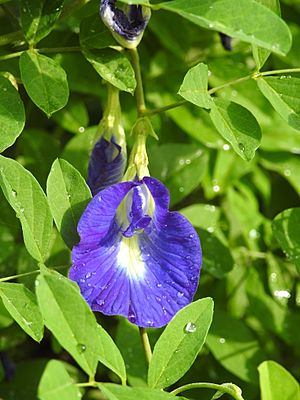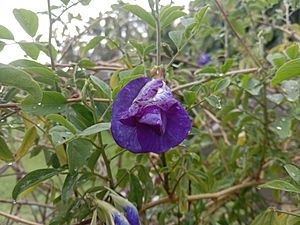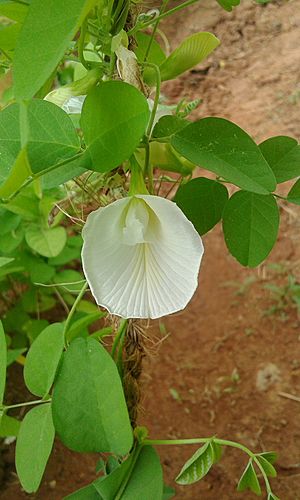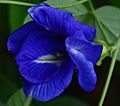Asian pigeonwings facts for kids
Quick facts for kids Asian pigeonwings |
|
|---|---|
 |
|
| Flowers and foliage | |
| Scientific classification | |
| Genus: |
Clitoria
|
| Species: |
ternatea
|
The Butterfly Pea (scientific name: Clitoria ternatea) is a beautiful plant known by many names like Asian pigeonwings or blue pea. It belongs to the Fabaceae family, which includes peas and beans.
In India, people see it as a special, holy flower. They often use it in daily puja rituals, which are religious ceremonies. The plant's scientific name, ternatea, might come from the city of Ternate. This city is in Indonesia, and it's where the famous scientist Linnaeus found his first samples of this plant.
Contents
Where Does the Butterfly Pea Grow?
This plant originally comes from warm, wet parts of Asia. This includes places in South Asia and Southeast Asia. But it has also been taken to other continents like Africa, Australia, and the Americas, where it now grows too.
What Does the Butterfly Pea Look Like?
The butterfly pea is a perennial plant, meaning it lives for more than two years. It is also a herbaceous plant, which means it has soft stems, not woody ones like trees. It grows as a vine or a creeper, spreading out over the ground or climbing. It grows best in soil that is moist and not too acidic or too alkaline.
The most amazing thing about this plant is its flowers. They are usually a bright, deep blue color. Each flower grows alone and has small, light yellow marks. They are about 4 centimeters (1.6 inches) long and 3 centimeters (1.2 inches) wide. Some types of butterfly pea plants even have white flowers.
The plant also produces fruits, which are flat pods. These pods are about 5 to 7 centimeters (2 to 2.8 inches) long. Each pod holds six to ten seeds. When the pods are young and soft, you can eat them.
People grow the butterfly pea as an ornamental plant because it looks pretty. It's also used to help damaged land, like old coal mines in Australia, grow plants again. This plant needs very little care. Because it's a legume (like peas and beans), its roots work with tiny soil bacteria called rhizobia. These bacteria help change nitrogen from the air into a form the plant can use. This process is called nitrogen fixing. Because of this, the butterfly pea also helps make the soil healthier when its nitrogen-rich parts break down.
Growing Butterfly Pea Plants
The butterfly pea plant is quite strong and usually doesn't have many problems with pests or diseases.
Common Pests
Sometimes, this plant might get a few caterpillars, whiteflies, or spider mites. But these problems are rare.
Plant Diseases
The butterfly pea can sometimes get diseases like anthracnose or bacterial soft rot. It rarely suffers from fungal root rots.
How People Use the Butterfly Pea
Cooking with Butterfly Pea Flowers
In Southeast Asia, people use the butterfly pea flower as a natural food coloring. It gives a beautiful blue color to sticky rice and desserts, like a dish called putugal. In Malaysia, it's a key ingredient in a dish called nasi kerabu, which gets its special blue color from the flowers. In Myanmar and Thailand, the flowers are sometimes dipped in batter and fried. It's also used to color the Nyonya dish Pulot tartal.
A popular drink is Butterfly pea flower tea, made from the dried flowers and lemongrass. What's cool about this tea is that its color changes! If you add lemon juice, it turns purple. In Thailand and Vietnam, this blue tea is often mixed with honey and lemon. This makes it more acidic and changes the drink to a pink-purple color. It's often served after dinner or as a refreshing drink at hotels. It's a common local drink, much like chamomile tea is in other parts of the world. You can drink it hot or cold.
Recently, the flowers have even been used in a special kind of gin. The gin looks blue in the bottle. But when you mix it with a fizzy mixer like tonic water, it turns pink! This happens because of a change in the liquid's pH level. Since natural colors can fade, this type of gin should be kept in a dark place to keep its color-changing effect.
Traditional Health Uses
In traditional Ayurvedic medicine, which is an ancient Indian healing system, the butterfly pea is believed to have many helpful qualities. It is thought to help with memory, reduce stress, and have calming effects. Scientific studies have also shown that extracts from this plant have many good properties. These include fighting germs, reducing fever, easing pain, and helping with blood sugar levels. This plant has been used for a long time in traditional medicine, and modern science is now confirming many of its benefits.
Dyeing with Butterfly Pea Flowers
The flower can also be used to dye natural fibers. Traditional communities in Asia have used it for a long time to color fabrics.
Gallery
-
Butterfly pea flower tea is made from C ternatea flowers
-
Thai khao tom sweet, colored blue with C. ternatea flowers
See also
 In Spanish: Conchita azul para niños
In Spanish: Conchita azul para niños









